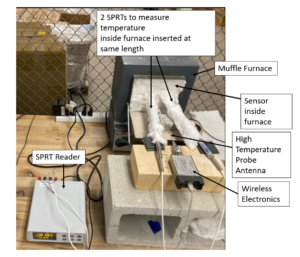
Increased Accuracy for On-Blade Measurements Demonstrates Ability to Help Optimize Engine Efficiency and Part Life Models to Maximize Engine Output and Eliminate Life Cycle Costs.
02.22.2021 |

*For a 0-600C (1,112F) range, this is a ±0.71% accuracy. *Note accuracy was determined based on Standard Platinum Resistance Thermometer’s temperature limits
*Hysteresis is ±1.7 °C.
*With a frequency point spacing of 200 kHz and the calibration slope of 442 kHz/°C, the sensitivity is ± 0.5C.
The advantages of obtaining blade measurements with on-blade sensors with accuracy greater than a Type K thermocouple helps OEMs make efficiency gains while eliminating life cycle costs. The accuracy of the sensing system was extremely good, on the average error of 2.7 °C, and a standard deviation of 0.73 °C. The current 95% confidence interval accuracy of the sensor is ± 4.2 °C. By utilizing two Standard Platinum Resistance Thermometers (SPRT), instead of just one, Sensatek’s temperature sensors are calibrated with industry standard precision and have demonstrated accuracy that empowers decision makers with information they need to accelerate product development and component validation timelines. Combined with real-time GUI and analytics, engine designers can make real-time decisions on the operating conditions of the turbine according to their needs. Efficiency gains can be achieved by trending actual surface temperatures more precisely in real-time on rotating components to help optimize cooling schemes. Active cooling is an important part of modern turbines, but those active cooling volumes come at an efficiency cost. If the real time temperature of the points of concern on specific blades can be reported with high accuracy in real time, then cooling flow designs or even real time cooling flow volumes can be adjusted. In this way part life can be preserved. Perhaps even more importantly, only the cooling that is needed is used, significantly increasing the efficiency of the turbine engine. This can have a strong impact on the CO2 emissions at given power levels. Life cycle costs can be eliminated from achieving enhanced part life models that could help extend useful life of parts. In many cases, the temperature sensitivity of rotation parts are the limiting factor of rotating components. Up until now, certain assumptions had to be made concerning the max temperature reached by such parts, and those assumptions can come with high levels of uncertainty. Utilizing precise, discrete temperature and strain measurements helps gas turbine engine end-users to accurately predict and prevent failure modes in real-time. These can also be used to provide insights into important flow features during engine and hot component development tests which can then in-turn be used to fine-tune computational models. By providing localized measurement points, as compared to field-averaged data enables accelerated validation times for component testing and simulations.